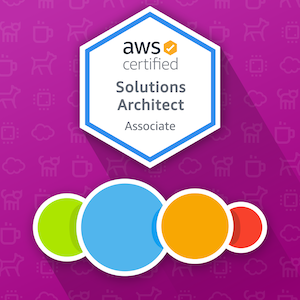 |
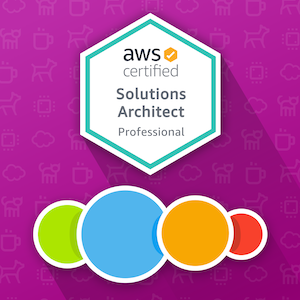 |
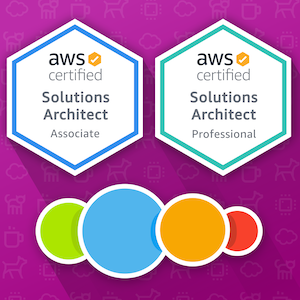 |
Full disclosure - I create online training courses for AWS, I currently have one for the AWS Certified Solutions Architect - Associate one for the AWS Certified Solutions Architect - Professional and a Bundle containing both. This article (I think) contains unbiased opinions & experiences, but I wanted to be clear about my perspective right at the start.
On March 23rd 2020 AWS Released a new version of the AWS Certified Solutions Architect - Associate (CSAA) exam. The exam was given a new code SAA-C02, a departure from the usual minor incremental changes to exams which AWS is known for. SAA-C02 represents a sweeping change to the associate architect exam, with some estimating a 30% change to subjects tested with a firm architecture focus.
This article represents my experiences on the exam, and feedback provided by the initial wave of students who’ve completed my Architect Associate course and gone on to pass the exam.
The article has a few main areas
- Training Material (no surprise I’ll be recommending my own)
- Topic hints and tips (my own, plus student feedback)
- Exam and Question Technique
- Study Notes from a student (curated)
- Additional suggestions for exam practice
Before you start, the topic hints n tips are in brain dump format, so don’t expect much in the way of sentence structure and grammar :)
Training Material
There are a range of courses available for the CSAA exam. Each course ranges in price, quality and how up to date the content is. I made a decision in later 2019 to create a brand new course for the SAA-C02 exam, rather than updating existing SAA-C01 content. My opinion then, and still now, is that the exam is a major update which requires major content changes. I stand behind my own material for SAA-C02 which I’ve been working on for the past few months - focussed specifically on the needs of the SAA-C02 exam. I’ve put in significant effort to make sure this is (IMO) the best material for confident exam passes.
Whatever material you choose, look for how recent the console looks, check for coverage of new products and features. If courses have lessons marked as C01 or C02 that should be a warning sign that it’s been designed for C01 and updated to C02.
Topic Hints and Tips
I’ve grouped my hints ‘n’ tips into topic areas below … I hope it helps.
COMPUTE
Ensure you are fully comfortable with the terms EC2 Family, Type, Size and generation. It’s not essential to remember them all, but understanding the concepts and the major differences is an advanced.
Understand what each family of instances is useful for in terms of workload types. A problem in a question could be a bad instance type selection - or it could be irrelevant.
You need a good understanding of the SPOT pricing model - benefits and downsides of the model. What type of work is it suited for and not suited for - i.e applications which can tolerate interruption.
What options exist for reserved purchases of instances. Scheduled vs term, Zonal vs Regional, 1 v 3 year, All upfront, partial vs no upfront.
If you need to reserve EC2 capacity, which reserved option(s) should you pick?
Understand how you can you create a ‘simple’ HA EC2 instance - ASG 1:1:1 (Lazy HA)
Can you copy an EC2 instance to another AZ? If so, how? If not, is there a workaround?
Learn the architectures of Cluster, Spread and Partition Placement groups. Make sure you are comfortable when you would use each. What are the requirements, limitations and supporting infrastructure.
Detailed knowledge of Launch Templates vs Launch Configurations - features of each, limitations of each, when to use one vs the other.
ECS Architecture - high level container understanding. When to use container services … pros vs cons. When to pick Fargate vs EC2. What’s the difference between the two? when would you pick to use one vs the other.
How do you allocate permissions to ECS Containers .. ? TASK Role.
Understand the Lambda Architecture - Runtime, execution limits, execution roles. How to grant permissions & how it scales.
What events can lambda be invoked by? What services integrate with lambda - a general understanding of what can be used as an event source is enough.
Understand how instance profiles work? How do they relate to instance roles. How are credentials passed into an instance. Understand access, rotation etc.
STORAGE
The SAA-C02 exam is full of S3 Questions. I’ve received a lot of feedback from students suggestions ~40% or more of the exam is focussed on S3.
Review the Storage type & Performance of EFS vs Instance Store vs EBS vs S3.
Object Storage Classes - what each does & offers. When to use one vs the other. Go into the exam with architectural patterns and anti-patterns for each class.
Understand how to configure and use an S3 static Website - and be comfortable with offloading style architectures from traditional applications to S3.
S3 Bucket policies, multi account access, public access. How does ownership work with cross-account access.
Understand Block Public Access Settings - it overrides things, know that it is the highest priority.
Consistency Model - write something (A), write an update (B), read it… is it A or B ?
Limit : Number of buckets per account …. this influences architecture. 1 bucket per user = bad, 1 prefix per user = good.
S3 can’t be mounted, its object storage - what does this mean. What is object vs file vs block storage.
S3 Versioning, how it works. Delete markers and Un-delete functionality (delete the delete marker)
MFA Delete - what is it, how does it work.
Understand S3 Events in general - using it for event-driven architectures.
Cross-Region and Same-Region Replication, features and architecture benefits. When would you use this.
When to use Snowball vs uploading data to AWS over a network connection (speeds, amounts, costs)
When to use Snowmobile vs uploading data vs using Snowball (speeds, amounts, costs)
For S3 encryption, understand for each (client-side encryption, SSE-C, SSE-S3, SSE-KMS) who manages the encryption/decryption process and who manages the keys. When would you use SSE-KMS vs SSE-S3 (Role separation)
EFS when should you use it ? Shared instance storage. For logs? Or cloud watch logs?
FSX - architecture, different file systems. The use cases for each. Windows systems feature more in SAA-C02 so FSx is more important vs SAA-C01.
Storage gateway - what the different modes are used for … file, volume, VTL
What IO levels are required to exclude EBS - It’s best to know the EBS volume and Instance limits.
EBS encryption - Architecture
EBS Snapshots - Architecture
EBS Encryption & Snapshots - Architecture
What is an AMI ? Creating an AMI.. copying an AMI, sharing an AMI.
NETWORKING
Basic VPC Architecture and config - IPv4 CIDR, IPv6
Subnet structure … limitations (1 subnet = 1AZ)
DHCP Option Sets - what can be adjusted.
Reserved IPs - for popular /XX prefixes.. how many usable IPs in a subnet.
Route Tables - architecture, how are they used. What is the route priority.
IPv4 and IPv6 default routes
Internet gateway .. features and limits, is it HA? Can it be made HA? how..
What is NAT.. how does it work. When is it used.
NAT Instances (Features, architecture, limitations), NAT Gateways (Same), GW vs Instances, SRC/DST check.
NAT and IPv6 ..why is it not needed? Can you explain why IPv6 doesn’t need NAT ?
Know what services an egress-only internet gateway provides and how they are configured.
DNS in a VPC .. public and private DNS what IPs are resolved?
SGs - features, limits, what are they attached too.. stateful
NACLs - features, limits, what are they attached too … explicit DENY & stateless.
You need to REALLY understand what an Ephemeral port is. Specifically know that an incoming tcp/80 stream of data has a return stream using ephemeral port range (not port 80!!) ..
How to secure a multi-tier application in a VPC … routes, NACL/SG
Know the common ports .. SSH, SQL, HTTP, HTTPS, RDP, SMTP, TELNET (it makes it easier to parse questions)
VPC Peering - limits and features, transitive (NOT). DNS resolution.
How does VPN work … IPSEC, Gateways, Authentication, IPs, Static v Dynamic.
Direct Connect, architecture, VIFs, public v private. Encryption over DX. Provisioning time vs VPN
Understand why you would provision a VPN First, then DX ..
When should DX be used … latency/large data amounts/complex networks.
Data transfer costs , internet IPs vs External.
General understanding of Instance Interfaces, IPs, DNS, using MAC address (for licensing)
Elastic IP - features, limitations, billing.
DATABASES
Understand the differences between OLTP and OLAP .. what is each used for.
For a given type of data (fnd keywords) know if SQL or NOSQL is required.
For SQL and NOSQL, for a give reliability, cost and performance situation know which DB product to pick.
DynamoDB capabilities … simple key value, wide column, no relations, no structure querying.
HA Capabilities of MSSQL (diff versions), RDS, Aurora and Aurora server less.
Aurora serverless questions were mentioned around scaling back to 0 - understanding that its capable of running with 0 load - paused cluster
When to use a read replica .. including multi-AZ RR
Knowing what MultiAZ does, vs Read Replica - for HA, MultiAZ = availability, RR = read scaling and improved RPO/RTO
Know that RDS (non-aurora) can’t access the standby instance, Aurora can - what benefits does this provide ….
Using Reporting via a RR as the source is a great architecture
How to create an encrypted version of an existing database …
Diagnose bad DB performance … only at 60% CPU .. what is the cause ? Disk? Use a read replica?
Understand which DB’s in AWS are delivered as a service, vs a Database Server as a service.
Understand EMR .. and how its architected at a high level, specifically which components an EMR cluster has…
CONTENT DELIVERY
CloudFront architecture - edge locations & regional caches.
Preventing access to a resource directly OAI .. how to do this if the origin is an ALB, one answer was custom headers.
Caching static and dynamic, how ? And how to optimize caching performance.
S3 transfer acceleration .. how is this different from cloud front
Any object size limit in cloud front ? know the answer to this.
ARCHITECTURE
Understand ASG’s - The different scaling policies. Scheduled Scaling, when would you use..? Target Scaling, when would you use..?
What configuration elements are configured in a LC/LT vs ASG
SQS as a decoupling architecture - allows one part of an architecture not to be held up by another.
S3 events … how do they link in with SNS and SQS.
If you want TWO different things to happen when an object is uploaded to s3 ..how is this architected … one SNS, 2 queues subbed. Make sure you understand this architecture.
How to achieve HA in region - ALB + EC2
How to achieve Global HA … S3 transfer acceleration, cross region replication, cloud front + S3
How does R53 work, how does it integrate with other services Latency/Geo DNS routing/
SQS vs Kinesis … there was a question about picking between the two. Be really sure on HOW to pick between. Make sure you are REALLY clear on this one, and ideally make it instinctive.
IAM, ACCOUNTS AND SECURITY
Detailed knowledge of Users, Groups, Roles - what each one provides, which ones you can login too, which ones you can assume. WHich can have policies. WHich have long term keys, which have short term keys.
policy 1 - ec2:*, IAM READ,DS:*, logs read, policy 2 - deny DS:delete, What is the result … can DS be deleted ?
Giving cross account permissions to S3 bucket … easiest way
Can you move an existing account in an ORG, what about between ORGS?
Understand AWS organizations - features, benefits, RAM
Service control policies - how they can be used to restrict access from a single management location.
Know the Process to invite accounts to an ORG
Cross account permissions, vs Cross account roles, via making identities in account - when and where, security, admin overhead etc.
KMS - when to use KMS, vs S3 encryption - don’t want to manage keys, but want to control access.
Securing the root account - strong password and MFA
How WAF integrates with services … applying an ACL
How to add white lists and blacklists
What do you change … the stuff on the ACL, not the ACL on the service.
Student Notes
One of my students made these notes they are pretty useful for the exam so make sure you take a look.
Exam and Question Technique
Students I’ve worked with in the past have experienced issues with exam technique. They simply didn’t prepare well enough - they didn’t know what to expect and had little exposure to how AWS questions are written or how to break them apart and answer quickly and effectively. In my SAA-C02 course I created 3 lessons focussed on improving technique - these are free and available to everyone regardless if you take my course or not.
EXAM TECHNIQUE
My course has a full lesson on exam technique where I detail a method of splitting the exam into three phases. In phase one, you go through the entire exam answering easy questions which you can deal with quickly. In Phase 2 you skip past hard questions (flagging for review) and focus on finishing the average difficulty questions. In phase 3 you answer, or guess, at the remaining hard questions.
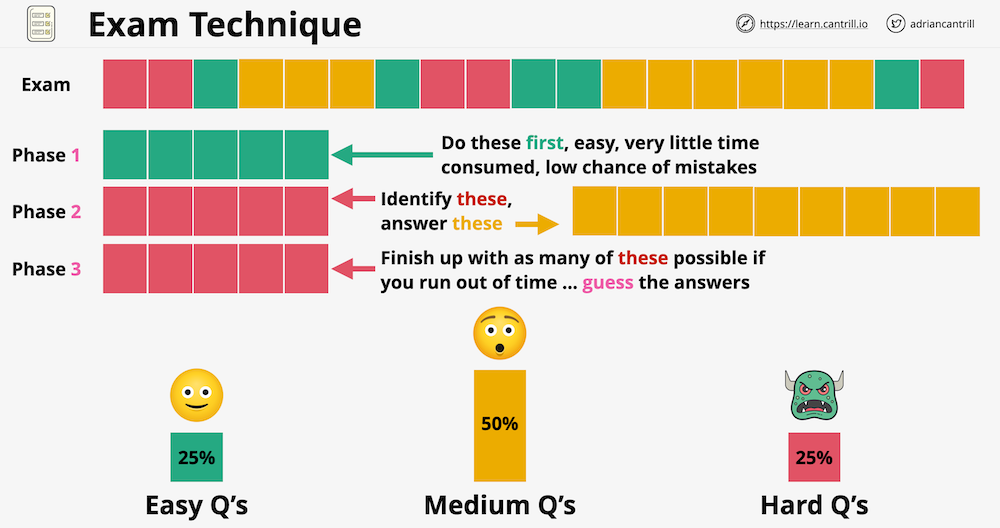
This way, your time is focussed on the questions which will generate the bulk of your exam result.
Question Technique
Beyond the exam at a high level, my course include two different lessons on question technique. I offer some suggestions on keyword analysis and answer elimination that many students have tried and saved significant time in the exam. Hopefully it will help save you some time.
Exam Question Practice
Most courses feature some practice exam questions, the course I’ve designed above two full sets of exams worth of questions. I’ve designed them to be 125% or so difficulty vs the exam. My logic, is that if you can improve to the point of answering these, your exam experience will be pretty chilled :)
In addition to my own material I’m a fan of Tutorialsdojo.com, they make excellent quality practice exam questions. These are the ones I recommend to most students taking my courses as extra material to work through.


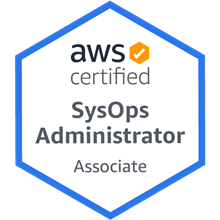
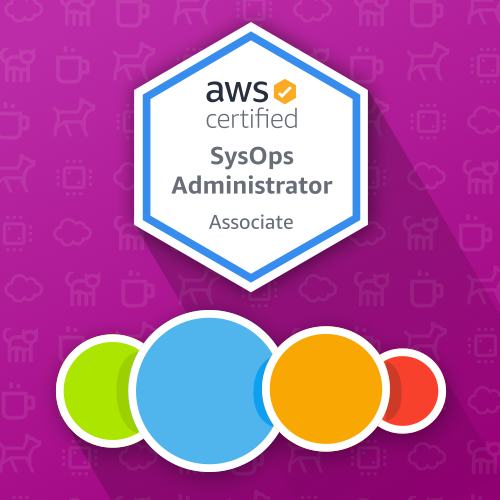
Comments